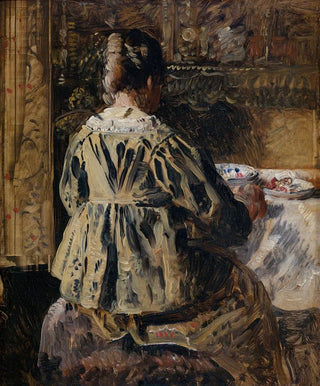Art print | The Meal or the Woman Seen from Behind - Henri de Braekeleer


View from behind

Frame (optional)
In the fascinating world of 19th-century Belgian art, the art print "Le Repas ou la Femme vue de dos" by Henri de Braekeleer stands out for its ability to capture moments of everyday life with remarkable delicacy and emotional depth. This painting, which depicts a woman turned away from the viewer, offers a unique perspective on domestic reality and solitude. The artist manages to create an intimate atmosphere, where every detail, from furniture to clothing textures, tells a story. The art print of this iconic work not only allows appreciation of Braekeleer's technique but also invites you to immerse yourself in a world filled with nostalgia and reflection.
Style and uniqueness of the art print
Braekeleer's style is characterized by meticulous realism, a keen attention to detail, and a subtle color palette. In "Le Repas ou la Femme vue de dos," the composition is carefully orchestrated, highlighting the silhouette of the woman while the rest of the scene remains in a gentle shadow. The interplay of light and shadow is skillfully used to emphasize the depth of space and the presence of the central figure. This work does not merely depict a mundane scene; it invites the viewer to contemplate the mystery of intimacy and isolation. The artist excels in suggesting more than he shows, creating a narrative tension that intrigues and captivates.
The artist and his influence
Henri de Braekeleer, born in 1840 in Antwerp, is often associated with the realist movement that gained momentum in Europe during the 19th century. Trained in a rich artistic environment, he developed a style that combines tradition and innovation. His work is marked by an exploration of themes of daily life, solitude, and human relationships. Braekeleer influenced many contemporary artists, notably through his approach to portraiture and genre scenes. His ability to capture the essence of his subjects allowed his work to transcend time, offering a reflection on the human condition that still resonates today. By paying homage to simple moments of life, he paved the way for

Matte finish

View from behind

Frame (optional)
In the fascinating world of 19th-century Belgian art, the art print "Le Repas ou la Femme vue de dos" by Henri de Braekeleer stands out for its ability to capture moments of everyday life with remarkable delicacy and emotional depth. This painting, which depicts a woman turned away from the viewer, offers a unique perspective on domestic reality and solitude. The artist manages to create an intimate atmosphere, where every detail, from furniture to clothing textures, tells a story. The art print of this iconic work not only allows appreciation of Braekeleer's technique but also invites you to immerse yourself in a world filled with nostalgia and reflection.
Style and uniqueness of the art print
Braekeleer's style is characterized by meticulous realism, a keen attention to detail, and a subtle color palette. In "Le Repas ou la Femme vue de dos," the composition is carefully orchestrated, highlighting the silhouette of the woman while the rest of the scene remains in a gentle shadow. The interplay of light and shadow is skillfully used to emphasize the depth of space and the presence of the central figure. This work does not merely depict a mundane scene; it invites the viewer to contemplate the mystery of intimacy and isolation. The artist excels in suggesting more than he shows, creating a narrative tension that intrigues and captivates.
The artist and his influence
Henri de Braekeleer, born in 1840 in Antwerp, is often associated with the realist movement that gained momentum in Europe during the 19th century. Trained in a rich artistic environment, he developed a style that combines tradition and innovation. His work is marked by an exploration of themes of daily life, solitude, and human relationships. Braekeleer influenced many contemporary artists, notably through his approach to portraiture and genre scenes. His ability to capture the essence of his subjects allowed his work to transcend time, offering a reflection on the human condition that still resonates today. By paying homage to simple moments of life, he paved the way for






